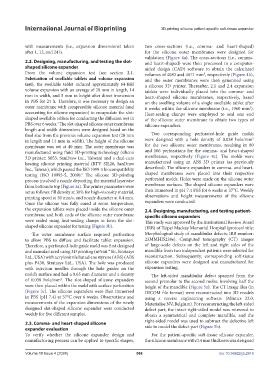Page 576 - IJB-10-4
P. 576
International Journal of Bioprinting 3D-printing silicone patient-specific soft-tissue expander
with measurements (i.e., expansion dimensions) taken two cross-sections (i.e., comma- and heart-shaped)
after 1, 12, and 24 h. for the silicone outer membranes were designed for
validation (Figure 4a). The cross-sections (i.e., comma-
2.2. Designing, manufacturing, and testing the slot- and heart-shaped) were then processed in a computer-
shaped silicone expander aided design (CAD) software to obtain the calculated
From the volume expansion test (see section 2.1. volumes of 4083 and 4671 mm , respectively (Figure 4b),
3
Fabrication of swellable tablets and volume expansion and the outer membranes were then generated using
test), the swellable tablet induced approximately 64-fold a silicone 3D printer. Thereafter, 2.1 and 2.4 expansion
volume expansion with an average of 28 mm in length, 14 tablets were individually placed into the comma- and
mm in width, and 5 mm in height after direct immersion heart-shaped silicone membranes, respectively, based
in PBS for 24 h. Therefore, it was necessary to design an on the swelling volume of a single swellable tablet after
outer membrane with compressible silicone material (and 6 weeks within the silicone membrane (i.e., 1960 mm ).
3
accounting for silicone expansion) to encapsulate the slot- Heat-sealing clamps were employed to seal one end
shaped swellable tablets for conducting the diffusion test in of the silicone outer membrane to obtain two types of
4
PBS over 6 weeks. The slot-shaped silicone outer membrane silicone expanders.
length and width dimensions were designed based on the
final size from the previous volume expansion test (28 mm Two corresponding perforated-hole guide molds
2
in length and 14 mm in width). The height of the silicone were designed with a hole density of 0.038 hole/mm
membrane was set at 40 mm. The outer membrane was for the two silicone outer membranes, resulting in 80
manufactured using fluid 3D-printing technology (silicon and 106 perforations for the comma- and heart-shaped
3D printer; S053, SanDraw Inc., Taiwan) and a dual-cure membranes, respectively (Figure 4c). The molds were
heating silicone printing material (RTV SIL28, SanDraw manufactured using an ABS 3D printer (as previously
Inc., Taiwan), which passed the ISO 1099-5 biocompatibility described). The silicone expanders in comma- and heart-
testing (ISO 10993-5, 2009). The silicone 3D-printing shaped membranes were placed into their respective
9
process involved a nozzle depositing the material layerwise perforated molds. Holes were made on the silicone outer
from bottom to top (Figure 3a). The printer parameters were membrane surfaces. The shaped silicone expanders were
set as follows: fill density at 30% for high-viscosity material, then immersed in pH 7.4 PBS for 6 weeks at 37°C. Weekly
printing speed at 30 mm/s, and nozzle diameter at 0.4 mm. observations and height measurements of the silicone
Once the silicone was fully cured at room temperature, expanders were conducted.
the expansion tablets were placed inside the silicone outer 2.4. Designing, manufacturing, and testing patient-
membrane and both ends of the silicone outer membrane specific silicone expanders
were sealed using heat-sealing clamps to form the slot- This study was approved by the Institutional Review Board
shaped silicone expander for testing (Figure 3b). (IRB) of Taipei Mackay Memorial Hospital (protocol title:
The outer membrane surface required perforation Morphological study of mandibular defects; IRB number:
to allow PBS to diffuse and facilitate tablet expansion. 23MMHIS238e). Computed tomography (CT) images
Therefore, a perforated-hole guide mold was first designed of large-scale defects on the left and right sides of the
and manufactured using 3D printing (uPrint ® SE, Stratasys mandible from two independent patients were selected for
Ltd., USA) with acrylonitrile butadiene styrene (ABS) (ABS reconstruction. Subsequently, corresponding soft-tissue
plus P430, Stratasys Ltd., USA). The hole was produced silicone expanders were designed and manufactured for
with injection needles through the hole guides on the expansion testing.
mold’s surface and had a 0.65 mm diameter and a density The left-sided mandibular defect spanned from the
of 0.038 hole/mm . The slot-shaped silicone expanders second premolar to the second molar, involving half the
2
were then placed within the mold with surface perforation height of the mandible (Figure 5a). The CT image files (in
(Figure 3c). The silicone expanders were then immersed DICOM file format) were reconstructed into 3D models
in PBS (pH 7.4) at 37°C over 6 weeks. Observations and using a reverse engineering software (Mimics 22.0,
measurements of the expansion dimensions of the newly Materialise NV, Belgium). For reconstructing the left-sided
designed slot-shaped silicone expander were conducted defect part, the intact right-sided model was mirrored to
weekly for five different samples. obtain a symmetrical and complete mandible, and the
right-sided model was used to subtract the defective left
2.3. Comma- and heart-shaped silicone side to model the defect part (Figure 5b).
expander evaluation
To verify whether the silicone expander design and For the patient-specific soft-tissue silicone expander,
manufacturing process can be applied to specific shapes, the silicone membrane with 0.4 mm thickness was designed
Volume 10 Issue 4 (2024) 568 doi: 10.36922/ijb.2918

